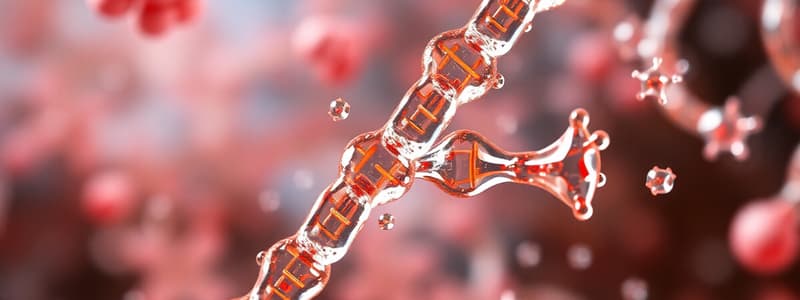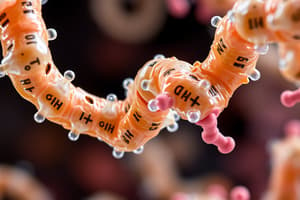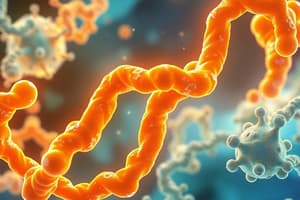Podcast
Questions and Answers
What occurs to the concentrations of products in a reaction when ΔG is less than 0?
What occurs to the concentrations of products in a reaction when ΔG is less than 0?
The concentrations of products will increase until ΔG equals 0.
Explain how enzymes affect the activation energy of a reaction.
Explain how enzymes affect the activation energy of a reaction.
Enzymes lower the activation energy, thus facilitating the formation of the transition state.
What is the relationship between ΔG and the equilibrium constant of a reaction?
What is the relationship between ΔG and the equilibrium constant of a reaction?
The standard free-energy change (ΔG°) is related to the equilibrium constant, as ΔG° can be calculated using the concentrations at equilibrium.
Define the Michaelis-Menten constant (Km) in the context of enzyme kinetics.
Define the Michaelis-Menten constant (Km) in the context of enzyme kinetics.
What characterizes first-order reactions with respect to reactant concentration?
What characterizes first-order reactions with respect to reactant concentration?
What is the significance of the transition state in enzyme-catalyzed reactions?
What is the significance of the transition state in enzyme-catalyzed reactions?
How do coenzymes differ from metal cofactors in their role in enzymatic activity?
How do coenzymes differ from metal cofactors in their role in enzymatic activity?
Describe the lock-and-key model and how it compares to the induced-fit model of enzyme-substrate binding.
Describe the lock-and-key model and how it compares to the induced-fit model of enzyme-substrate binding.
Why is substrate specificity important for enzymes, and can you provide an example?
Why is substrate specificity important for enzymes, and can you provide an example?
What defines a holoenzyme and an apoenzyme?
What defines a holoenzyme and an apoenzyme?
Flashcards
Enzyme
Enzyme
A biological catalyst, predominantly a protein, that speeds up biochemical reactions.
Substrate
Substrate
The reactant in an enzyme-catalyzed reaction.
Enzyme Specificity
Enzyme Specificity
Enzymes typically target and bind to specific substrates.
Cofactor
Cofactor
Signup and view all the flashcards
Holoenzyme
Holoenzyme
Signup and view all the flashcards
Apoenzyme
Apoenzyme
Signup and view all the flashcards
Catalytic Site
Catalytic Site
Signup and view all the flashcards
Binding Site (Active Site)
Binding Site (Active Site)
Signup and view all the flashcards
Transition State
Transition State
Signup and view all the flashcards
Gibbs Free Energy (ΔG)
Gibbs Free Energy (ΔG)
Signup and view all the flashcards
Spontaneous Reaction
Spontaneous Reaction
Signup and view all the flashcards
ΔG of a reaction
ΔG of a reaction
Signup and view all the flashcards
Standard Free-Energy Change (ΔG°)
Standard Free-Energy Change (ΔG°)
Signup and view all the flashcards
Equilibrium Constant (K)
Equilibrium Constant (K)
Signup and view all the flashcards
First-order reaction
First-order reaction
Signup and view all the flashcards
Michaelis-Menten constant (Km)
Michaelis-Menten constant (Km)
Signup and view all the flashcards
Vmax
Vmax
Signup and view all the flashcards
kcat
kcat
Signup and view all the flashcards
Catalytic Efficiency
Catalytic Efficiency
Signup and view all the flashcards
Enzyme
Enzyme
Signup and view all the flashcards
Activation Energy
Activation Energy
Signup and view all the flashcards
Study Notes
Enzymes as Remarkable Catalysts
- Enzymes speed up biochemical reactions.
- Most enzymes are proteins, some are RNAs.
- Enzymes stabilize the transition state (highest energy state in reaction).
- Enzymes function optimally at specific temperatures and pH levels.
Enzymes Catalyze Highly Specific Reactions
- Reactants in enzyme-catalyzed reactions are called substrates.
- Enzymes are highly specific, like proteolytic enzymes that hydrolyze peptide bonds between amino acids.
Proteases Break Peptide Bonds
- Proteases readily break peptide bonds.
Enzyme Cofactors
- Many enzymes require cofactors (non-protein molecules or ions) for activity.
- Coenzymes and metals are two main cofactor classes.
- A holoenzyme is an enzyme with its cofactor; an apoenzyme lacks a cofactor.
Active Sites of Enzymes
- Enzymes have catalytic and binding sites.
- The catalytic site is where the reaction occurs.
- The binding site (active site) is where substrates bind, forming an enzyme-substrate complex.
- Binding is highly specific, promoting the catalytic reaction. (Lock-and-key and induced-fit models illustrate this).
Thermodynamics and Enzymes
- Gibbs Free Energy (G) is a useful thermodynamic function.
- The change in Gibbs Free Energy (ΔG) indicates if a reaction will proceed forward or backward.
- ΔG depends only on the free energy difference between reactants and products.
- ΔG does not indicate the speed of the reaction.
Enzyme Rate Acceleration
- Enzymes accelerate the reaction rate but do not change the equilibrium point. Reaction will proceed to equilibrium quickly with an enzyme.
Michaelis-Menten Kinetics
- Describes enzyme kinetics.
- Km = Michaelis-Menten constant (a substrate concentration), and Vmax=maximum reaction rate.
- kcat = turnover number showing catalytic efficiency of the enzyme (kcat/Km).
- Plots (Lineweaver-Burk/Eadie-Hofstee) used to analyze the data for Km and Vmax
Allosteric Regulation
- Allosteric enzymes have multiple active sites on different protein subunits.
- Allosteric activators increase enzyme activity.
- Allosteric inhibitors decrease enzyme activity.
- Cooperativity = substrate can act as an allosteric activator
- Enzyme inhibitors or activators bind to an allosteric site and not the active site
Enzyme Inhibition
- Competitive inhibition: inhibitor competes with substrate for active site.
- Noncompetitive inhibition: inhibitor binds to an allosteric site, reducing overall enzyme efficiency.
Examples of Enzymes
- Examples of enzymes that follow Michaelis-Menten kinetics or not, like proteases (e.g., chymotrypsin) and others. (e.g., Phosphofructokinase, glycogen phosphorylase) given for reference
Studying That Suits You
Use AI to generate personalized quizzes and flashcards to suit your learning preferences.





